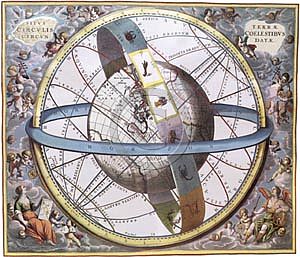



Local Coordinates:
1. On the diagram on the left (representing a view from around our latitude), label the
a. zenith
b. horizon
c. meridian
d. the North Star
2. Define the following (include the tool you'd use to measure them)
a. azimuth
b. altitude
Where would you measure each of the above on the diagram for the north star?
3. On the diagram on the right, write the azimuth in degrees for each of the compass directions.

4. On the representation of the celestial sphere above, label the
a. celestial equator
b. north celestial pole
c. south celestial pole
d. ecliptic
5. On the representation of the celestial sphere above, give an example of a
a. line of declination
b. line of right ascension
What units are each of the above measured in?
6. On the celestial sphere above,
a. where is Polaris and what is its declination?
b. What is the declination of the celestial equator?
7. Why do the sun and planets appear to move through the "fixed" stars?
8. At what angle is the ecliptic inclined with respect to the celestial equator and why?
9. Along what line does the sun move? Where would the sun be located on the
a. vernal equinox?
b. summer solstice?
c. autumnal equinox?
d. winter solstice?
10. How were each of the following chosen?
a. Oo declination
b. O h right ascension
11. On a terrestrial globe, what are the equivalents for
a. celestial equator
b. north celestial pole
c. south celestial pole
d. right ascension
e. declination
Orienting the celestial sphere for an observer living at 30o north latitude.

12. Label the zenith, +30o declination. Using a protractor, make marks along the meridian every 10o on either side of the zenith. Label each mark with its declination. Label the North Star and the celestial equator. Draw a line from the North Star to where the observer is standing. What is the altitude of the North Star?
13. Think of the stars moving from east to west in counterclockwise circles around the North Star. What is the range of declinations for stars that will be circumpolar (will never rise or set and, therefore, always be visible)? (Hint: Look at the declination on the northern horizon.)
14. What is the range of declinations for stars that will never be visible in the Northern Hemisphere? (Hint: Look at the declination on the southern horizon.)
15. Explain a method for locating lines of declination, the celestial equator, and the north celestial pole depending on your latitude.